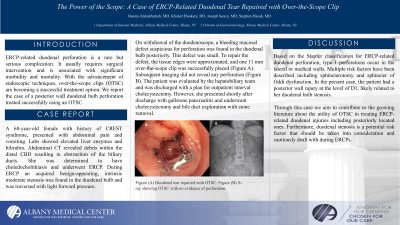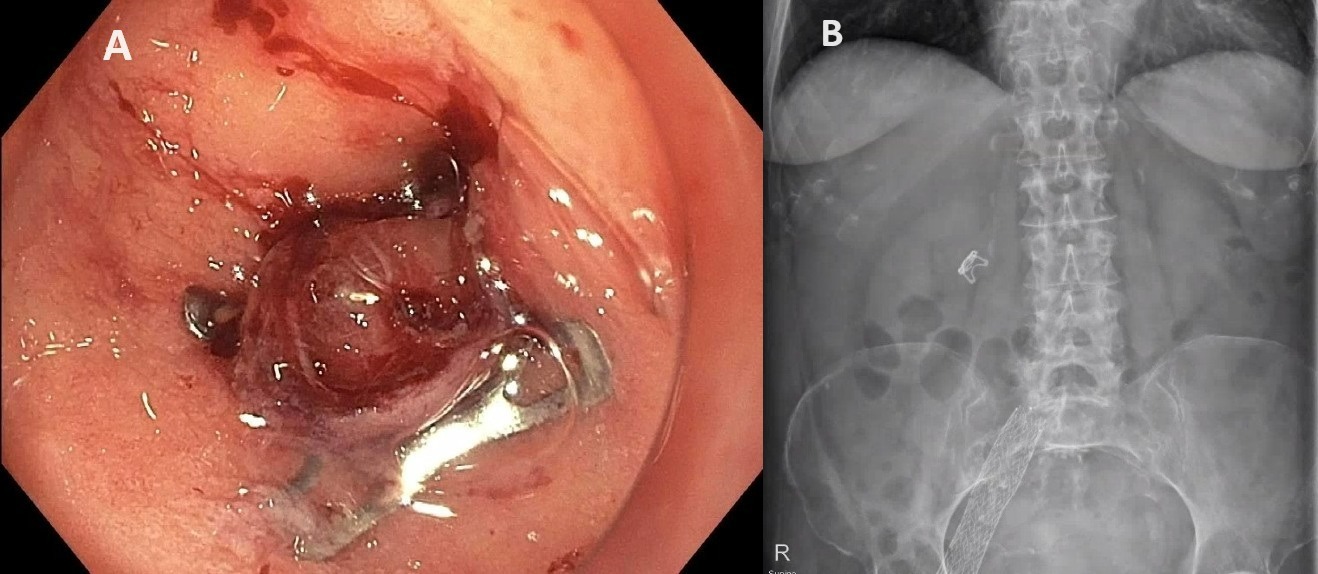Monday Poster Session
Category: Interventional Endoscopy
P2844 - The Power of the Scope: A Case of ERCP-Related Duodenal Tear Repaired with Over-the-Scope Clip
Monday, October 28, 2024
10:30 AM - 4:00 PM ET
Location: Exhibit Hall E

Has Audio

Osama Alshakhatreh, MD
Albany Medical Center
Albany, NY
Presenting Author(s)
Osama Alshakhatreh, MD1, Khaled Elsokary, DO1, Joseph Soucy, MD1, Stephen Hasak, MD, MPH2
1Albany Medical Center, Albany, NY; 2Albany Medical College, Albany, NY
Introduction: ERCP-related duodenal perforation is a rare but serious complication. It usually requires surgical intervention and is associated with significant morbidity and mortality. With the advancement of endoscopic techniques, over-the-scope clips (OTSC) are becoming a successful treatment option. We report the case of a posterior wall duodenal bulb perforation treated successfully using an OTSC.
Case Description/Methods: A 68-year-old female with history of CREST syndrome, presented with abdominal pain and vomiting. Labs showed elevated liver enzymes and bilirubin. Abdominal CT revealed debris within the distal CBD resulting in obstruction of the biliary ducts. She was determined to have choledocholithiasis and underwent ERCP. During ERCP an acquired benign-appearing, intrinsic moderate stenosis was found in the duodenal bulb and was traversed with light forward pressure. On withdrawal of the duodenoscope, a bleeding mucosal defect suspicious for perforation was found in the duodenal bulb posteriorly. This defect was small. To repair the defect, the tissue edges were approximated, and one 11 mm over-the-scope clip was successfully placed (Figure A). Subsequent imaging did not reveal any perforation (Figure B). The patient was evaluated by the hepatobiliary team and was discharged with a plan for outpatient interval cholecystectomy. However, she presented shortly after discharge with gallstone pancreatitis and underwent cholecystectomy and bile duct exploration with stone removal.
Discussion: Based on the Stapfer classification for ERCP-related duodenal perforation, type 1 perforations occur in the lateral or medical walls. Multiple risk factors have been described including sphincterotomy and sphincter of Oddi dysfunction. In the present case, the patient had a posterior wall injury at the level of D1, likely related to her duodenal bulb stenosis.
Through this case we aim to contribute to the growing literature about the utility of OTSC in treating ERCP-related duodenal injuries including posteriorly located ones. Furthermore, duodenal stenosis is a potential risk factor that should be taken into consideration and cautiously dealt with during ERCPs.

Disclosures:
Osama Alshakhatreh, MD1, Khaled Elsokary, DO1, Joseph Soucy, MD1, Stephen Hasak, MD, MPH2. P2844 - The Power of the Scope: A Case of ERCP-Related Duodenal Tear Repaired with Over-the-Scope Clip, ACG 2024 Annual Scientific Meeting Abstracts. Philadelphia, PA: American College of Gastroenterology.
1Albany Medical Center, Albany, NY; 2Albany Medical College, Albany, NY
Introduction: ERCP-related duodenal perforation is a rare but serious complication. It usually requires surgical intervention and is associated with significant morbidity and mortality. With the advancement of endoscopic techniques, over-the-scope clips (OTSC) are becoming a successful treatment option. We report the case of a posterior wall duodenal bulb perforation treated successfully using an OTSC.
Case Description/Methods: A 68-year-old female with history of CREST syndrome, presented with abdominal pain and vomiting. Labs showed elevated liver enzymes and bilirubin. Abdominal CT revealed debris within the distal CBD resulting in obstruction of the biliary ducts. She was determined to have choledocholithiasis and underwent ERCP. During ERCP an acquired benign-appearing, intrinsic moderate stenosis was found in the duodenal bulb and was traversed with light forward pressure. On withdrawal of the duodenoscope, a bleeding mucosal defect suspicious for perforation was found in the duodenal bulb posteriorly. This defect was small. To repair the defect, the tissue edges were approximated, and one 11 mm over-the-scope clip was successfully placed (Figure A). Subsequent imaging did not reveal any perforation (Figure B). The patient was evaluated by the hepatobiliary team and was discharged with a plan for outpatient interval cholecystectomy. However, she presented shortly after discharge with gallstone pancreatitis and underwent cholecystectomy and bile duct exploration with stone removal.
Discussion: Based on the Stapfer classification for ERCP-related duodenal perforation, type 1 perforations occur in the lateral or medical walls. Multiple risk factors have been described including sphincterotomy and sphincter of Oddi dysfunction. In the present case, the patient had a posterior wall injury at the level of D1, likely related to her duodenal bulb stenosis.
Through this case we aim to contribute to the growing literature about the utility of OTSC in treating ERCP-related duodenal injuries including posteriorly located ones. Furthermore, duodenal stenosis is a potential risk factor that should be taken into consideration and cautiously dealt with during ERCPs.

Figure: Figure (A) Duodenal tear repaired with OTSC. Figure (B) X-ray showing OTSC with no evidence of perforation.
Disclosures:
Osama Alshakhatreh indicated no relevant financial relationships.
Khaled Elsokary indicated no relevant financial relationships.
Joseph Soucy indicated no relevant financial relationships.
Stephen Hasak indicated no relevant financial relationships.
Osama Alshakhatreh, MD1, Khaled Elsokary, DO1, Joseph Soucy, MD1, Stephen Hasak, MD, MPH2. P2844 - The Power of the Scope: A Case of ERCP-Related Duodenal Tear Repaired with Over-the-Scope Clip, ACG 2024 Annual Scientific Meeting Abstracts. Philadelphia, PA: American College of Gastroenterology.
